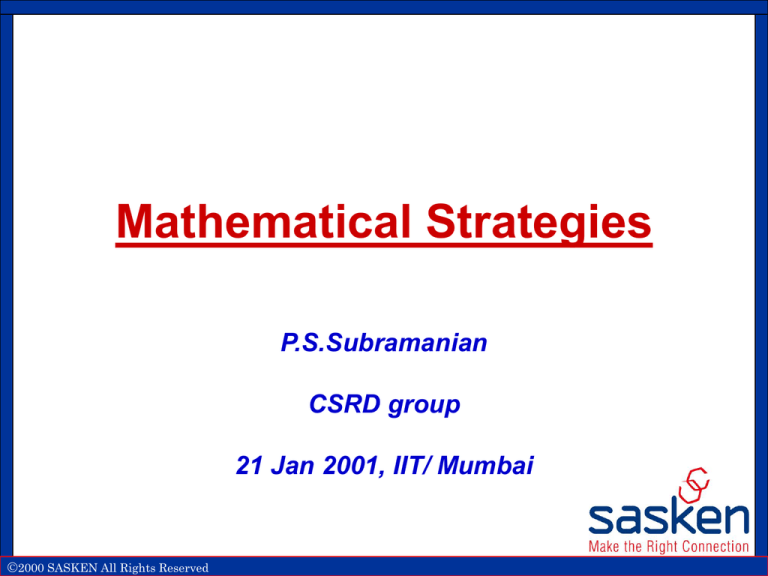
Mathematical Strategies
P.S.Subramanian
CSRD group
21 Jan 2001, IIT/ Mumbai
2000 SASKEN All Rights Reserved
Mathematical StrategiesStrategy vs Tactics - in Chess
Tactics is situation specific and
concrete
Strategy is generic and abstract
Pros and Cons of Strategy and Tactics
2000 SASKEN All Rights Reserved
Mathematical Strategies Why study the Strategies of Mathematics?
Helps us to `see the forest for the trees’.
Makes the learning of `new’ topics easier.
Makes the study of `History of Mathematics’
more meaningful.
2000 SASKEN All Rights Reserved
Some Common Strategies
Encapsulation for representation
independence
Step-wise refinement
Coordinatisation (Cartesian, Positional and
Mixed)
Reuse
Linearisation
Localisation
Crowding
Dualisation
2000 SASKEN All Rights Reserved
Encapsulation
Need to study properties independent
of the `representation’.
In Computer Science the essence of
OOP
Representation = Implementation
2000 SASKEN All Rights Reserved
Encapsulation - Example
Injectivity of function
f : A —› B, where A, B are Sets
un-encapsulated definition is
a, b in A, f(a) = f(b) => a = b
Can we give a definition without in?
2000 SASKEN All Rights Reserved
Encapsulation - example
Encapsulated Definition
let C be another set and
g , h : C —› A, be two maps
f is injective iff, f ° g= f ° h => g=h
Elements have vanished.
2000 SASKEN All Rights Reserved
Encapsulation
This line of thinking leads to `Category Theory’
For a gentle introduction see
`Conceptual Mathematics’ by
William Lawvere - Prentice Hall.
Strongly Recommended for CS Students
2000 SASKEN All Rights Reserved
Step-wise Refinement
Given a collection of problems P which we know
how to solve, and a new problem Q
Find a sequence of subproblems with the
property that we have a method of transforming
the solution of problems occurring later in the
sequence to those of the earlier.
2000 SASKEN All Rights Reserved
Stepwise Refinement
In particular
if the tail of the sequence has problems only
from the set P
then we can solve Q.
2000 SASKEN All Rights Reserved
Stepwise Refinement
Gaussian Elimination - What is P and Q?
Galois Theory - What is P and Q?
Let P be a set of Software specifications for which
we have already written programs
and Q is new specification for which we want to
develop a program.
2000 SASKEN All Rights Reserved
Stepwise Refinement
Component based Software (and Hardware)
Engineering
is an important and evolving area.
Sample reference see http://www.kestrel.edu
2000 SASKEN All Rights Reserved
Co-ordinatisation
Cartesian
Positional
Mixed
2000 SASKEN All Rights Reserved
Cartesian
Synthetic Projective Geometry
Underlying `Mathematics’ is
Wedderburn’s Representation Theorem of
Semi-simple rings in terms of Matrix rings over
division algebras.
2000 SASKEN All Rights Reserved
Cartesian
The idea of coordinatising
the Space of Functions
enables us to transport
many ideas from the usual coordinate geometry
to these spaces.
2000 SASKEN All Rights Reserved
Positional
Decimal Number System
Wavelets
Underlying Mathematics is that of Wreath Products
Krasner-Kaloujnine Theorem of
Embedding a group in the wreath product of the
factors of it’s composition series.
2000 SASKEN All Rights Reserved
Mixed
Krohn- Rhodes Theorem in Automata Theory
and it’s generalisations
Underlying Mathematics is the theory of
Semigroup Decompositions
2000 SASKEN All Rights Reserved
Reuse
If we have already solved a problem in some
domain and if can establish a suitable connection
between domains
then we can `reuse’ the solutions of problems of the
former domain.
2000 SASKEN All Rights Reserved
Reuse
Example (NOT historically accurate!)
Galois Theory (again)
Original Domain - Groups
Problem- Stepwise Refinement
New Domain - Fields
Suitable Connection - Galois Connection
2000 SASKEN All Rights Reserved
Reuse
The Specware software from the Kestrel Institute
provides mechanisms for reuse of
ideas in the domain of Algorithm Design.
But, contrary to Galois theory which is fully
automatic
one has to provide the connection manually.
2000 SASKEN All Rights Reserved
Linearisation
Newton-Raphson
Temporarily pretend that the situation is linear
Generalisation - Kantorovich to Fn Spaces
Structural Linearisation - Algebraic Topology
Linear to Module to Abelian Categories
2000 SASKEN All Rights Reserved
Mathematical Strategies
Localisation - Sheaf Theory
Representation Theorem of Rings
Minkowski-Hasse on Quadratic Forms
Many Computer Science uses of Sheaf Theory
2000 SASKEN All Rights Reserved
Mathematical Strategies
Crowding - Contraction Maps, Ramsey Theory
Fixed point Theorems and their uses.
Duality- Fourier Transforms, Spectral Methods, Chu
Spaces, Ramsey = Discontinuous Duality,
2000 SASKEN All Rights Reserved
Mathematical Strategies
Conclusion
One gets more insight into Mathematics and it’s
applications by reflecting on the strategies.
2000 SASKEN All Rights Reserved
Some Mathematical Topics relevant to
Sasken
Separating the strands in Signal Processing.
Generalising Shannon’s Information Theory
New Coding Techniques
Mathematics of Image processing
Mathematical aspects of Componentisation
2000 SASKEN All Rights Reserved





